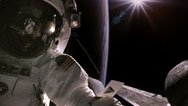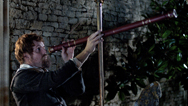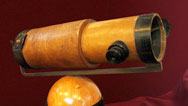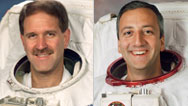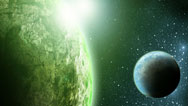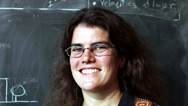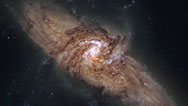
Hunting the Edge of Space: Hr 1
The Mystery of the Milky Way: From Galileo's to today's, telescopes have opened grand vistas onto our galaxy and beyond. Airing June 20, 2012 at 9 pm on PBS Aired June 20, 2012 on PBS
- Originally aired 04.06.10
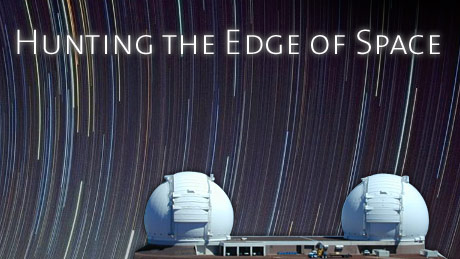
Program Description
Transcript
Hunting the Edge of Space: Hour 1
PBS Airdate: April 6 and 13, 2010
NARRATOR: April, 1990: NASA launches the Hubble space telescope, the first in a new generation of space telescopes, unlocking the secrets of the cosmos.
GEOFF MARCY (University of California, Berkeley): They're going to tell us in detail what our universe is made of, how it was born, how our universe is evolving.
NARRATOR: High-tech telescopes, like Hubble, take us back to the dawn of time, to the very birth of the universe, show us giant clouds where stars and planets are born.
BILL LATTER (NASA Herschel Science Center): Each time a new telescope looks in a different way at the universe, we learn something new and profound about the universe.
NARRATOR: In stunning clarity, we can now watch stars exploding, galaxies colliding and the violence of black holes.
KIM WEAVER (NASA Goddard Space Flight Center): There's a whole hidden universe out there.
MARIO LIVIO (Space Telescope Science Institute): We see the universe continuously changing and evolving.
NARRATOR: At this 20th anniversary of Hubble's launch, revolutions in telescope technology continue to push forward the frontiers of space.
MATT MOUNTAIN (Space Telescope Science Institute): Every time you try and explore a new part of the universe, we have these great discoveries and these great surprises.
NARRATOR: But where did this race begin? Where will it take us? This is the remarkable journey through 400 years of an extraordinary device that is changing everything we thought we knew.
KIM WEAVER: Telescopes have revolutionized our understanding of ourselves, our place in the cosmos and where we come from.
NARRATOR: Hunting the Edge of Space, up now, on NOVA.
Giant doors, eight stories high, slide apart. These twin eyes are preparing to look into deepest space. They belong to the Large Binocular Telescope.
It is one of the most powerful telescopes on Earth, costing over one hundred and twenty million dollars. These 28-foot wide mirrors collect light from objects millions of times fainter than anything our eyes can see. Six-hundred tons of machinery turn the mirrors to look more than 13 billion light-years away, to the very edges of the visible universe.
Super telescopes like this are taking real images that illuminate the darkest corners of our skies.
Billowing clouds of gas and dust are buffeted by supersonic winds and lit up by thousands of energetic new stars. Fifty-seven-trillion miles high, these giant clouds of gas and dust are stellar nurseries, hiding the very birthplaces of stars and planets.
Suddenly, a star's explosive death sends its superheated gas ripping through space at hundreds of miles per second. And in far away galaxies, we can take images of invisible jets of energy screaming out from one of the most mysterious objects: a supermassive black hole—all because of high-tech telescopes.
MATT MOUNTAIN: The telescope has changed the way we, as a species, think about ourselves.
KIM WEAVER: With a new telescope, you're always going to find something new, because you always add to your ability to see more.
NARRATOR: These breathtaking images are only possible because extraordinary telescopes like these are staring out, night after night, across the globe and in space.
Over the past four centuries, revolutions in technology have transformed this groundbreaking instrument. So where did it all begin?
The journey starts with one man and two pieces of glass.
It is the summer of 1609. Mathematics professor Galileo Galilei is building his own version of an extraordinary new invention. It is the "telescope," a name that means "far-seeing" in ancient Greek.
The invention has spread like wildfire across Europe. From a small town in Holland, spectacle makers, working on the most precise glass lenses of the day, discovered that two different types of lenses, held at just the right distance, produce a surprising optical effect.
They act like a magnifying glass for distant objects. This is the birth of the telescope.
Galileo immediately sees the potential of the invention.
JIM BENNETT (Oxford University): Galileo's a practical mathematician, that's his trade. He designs instruments, he teaches the use of these instruments and these instruments are often used for warfare.
NARRATOR: Galileo works out how to increase the magnifying power of the telescope to eight times what our naked eyes can see. And he hits on a military use for it.
JIM BENNETT: And it would be a particular advantage if you could see the enemy before he can see you.
NARRATOR: The Venetian military buys this new device as a spyglass for spotting enemy ships.
But then Galileo turns his telescope from the earth to the sky and starts a revolution.
JIM BENNETT: By turning the telescope to the heavens, Galileo enters a whole new regime of practice where this, this instrument can be used to discover things we didn't know, before, about the world.
NARRATOR: All astronomers knew of the heavens, before Galileo, was what they could see with the naked eye: the stars and the moon.
But today, even amateur astronomers can see much, much more. Alexandra Hall spends her nights gazing up at the night sky from her backyard.
ALEXANDRA HALL (Amateur Astronomer): I never get bored of looking at the night sky above our heads. It's like 2,000 diamonds sprinkled across black velvet, the stars...and then the moon arises, and watching the moon go through it's phases, I mean, it looks different every time you look at it.
NARRATOR: To the naked eye, five stars sometimes appear brighter than the rest. And watched over the course of nights, they seem to move against the backdrop of the other stars.
ALEX HALL: They don't just stay in the same place like all the rest of the stars. They move around. Sometimes they're visible, sometimes they're not.
NARRATOR: Each of these bright stars is a "planet," a name that simply means "wanderer," in Greek. Venus, the evening star, skims the horizon at sunset; Mars glows red; Jupiter and Saturn outshine everything around them.
We now know that these wandering stars are actually other worlds like the Earth, planets, as we understand them today. But in Galileo's time, everyone believes they are just stars, there is only one world in the universe, our Earth, and it sits at the very center of everything.
The Sun appears to circle the Earth during the day, and over the long course of the night, the Moon and stars also appear to rotate across the heavens, circling the Earth in giant orbits.
ALEX HALL: When you stand outside, even just for a few hours, at night, you suddenly notice that all the stars, all the planets and the Moon—everything is wheeling around your head. It's like you're at the center of things...really, quite a powerful feeling.
NARRATOR: But Galileo is about to show that this is just a feeling. He starts to shake the known world order, when he looks at the Moon. The belief, in his day, was that all the heavenly bodies were flawless.
ALBERT VAN HELDEN (University of Utrecht): In the old cosmology, the Moon was a heavenly body and, therefore, perfect.
NARRATOR: But looking across a quarter of a million miles of space, Galileo sees something very different from the smooth sphere he expects. He sees, instead, a moon scarred with craters and valleys.
GEOFF MARCY: It must've been an extraordinary moment for Galileo, to peer with his little itty-bitty, crummy telescope, at the moon, and see craters, mountain ridges, valleys. He saw, for the first time, geographical terrain on another astronomical object.
NARRATOR: This means our Earth is not unique in the cosmos.
JIM BENNETT: These patches you see are mountains, so the Moon, it isn't smooth; it's like the Earth.
NARRATOR: But this is just the beginning. Next, Galileo turns his telescope on Jupiter, one of the wandering stars. He sees it as no one has ever seen it before.
This is an exact computer reconstruction of what Jupiter looked like through Galileo's telescope. Calibrated on Galileo's actual lenses, it shows what a challenge he faced. A replica of his telescope reveals how hard it is to get a still image.
ALEX HALL: Well, when I actually got Jupiter in the telescope, it was really difficult to focus, because, I guess, the lens quality is not very good, compared to the lenses that we would get today.
NARRATOR: To the naked eye, Jupiter looks like a bright star, a spot of light. Seen through Galileo's telescope, all other stars remain as spots of light, but Jupiter suddenly appears as a much larger, round disk.
This blurry, shaky view of Jupiter is a revelation. Galileo comes to an extraordinary conclusion: Jupiter must be a sphere, another world, a planet, as we understand it today.
And around it are even more surprises.
GEOFF MARCY: Picture yourself: you've just glued a little piece of glass on the front of a long tube, and to your utter surprise, you see two or three or maybe even four stars next to Jupiter, like little ducklings following a duck.
NARRATOR: Night after night, Galileo notes the changing position of these new stars.
GEOFF MARCY: Imagine your utter surprise. Why should stars be following Jupiter? And, of course, Galileo learned only after a week or two of watching those little ducklings following their mother duck that those, in fact, were moons orbiting Jupiter.
NARRATOR: Galileo knows he has something spectacular on his hands. He publishes his findings in a book, called The Starry Messenger.
ALBERT VAN HELDEN: To my idea, it is the most explosive scientific book ever written. Its impact was immediate. Galileo became a superstar, overnight.
NARRATOR: But the biggest revelation is yet to come. Galileo is recording something that will change our view of the universe forever.
He observes the planet Venus changing shape and size, over a period of months. As Galileo watches, Venus transforms, week after week, from a large crescent to a small round disk. Then shadows creep again across the planet, returning it to a large crescent.
To Galileo, the pattern of shadows he sees on Venus can only mean one thing: Venus is going around the Sun. But the belief, at the time, was that everything circled the Earth. Earth is no longer the center of the cosmos.
KIM WEAVER: And so it said to us, "Wow, we're not at the center of the universe anymore."
WENDY FREEDMAN (Carnegie Observatories): These very simple observations literally rocked the foundations of the world. No longer is the Earth the center of the universe; the Sun is the center of the universe, despite what our ordinary senses tell us.
NARRATOR: But these discoveries famously bring Galileo into direct conflict with the Roman Catholic Church. The church taught that God placed mankind on Earth, at the very center of creation.
MASSIMO MAZZOTTI (University of California, Berkeley): Defending a sun-centered universe, Galileo was actually challenging the authority of the church. He was contradicting what was considered as the legitimate interpretation of the Bible, and the church couldn't tolerate this.
NARRATOR: But what Galileo saw is the solar system we understand today.
ALBERT VAN HELDEN: The discoveries that Galileo made, they changed the world forever: the world of science, the relationship between science and religion and the universe, forever.
NARRATOR: This is the universe Galileo helps reveal: planets and their moons, orbiting the Sun.
Telescopes, today, now reveal this solar system in detail that Galileo could only dream of: explosions on the surface of the Sun, the power of a billion megatons of T.N.T.; features in the great red spot on Jupiter, a vast stormy vortex large enough to swallow three Earths. On Jupiter's moon, Io, we can watch volcanoes spew gas and ash high into space, on Mars, a canyon five times deeper than the Grand Canyon and a volcano three times higher than Everest; on the surface of Venus, beneath roiling clouds of sulphuric acid, mountains rise from the rocky surface; and circling the sun, at the very perimeters of our solar system, dwarf planets made of rock and ice.
But one planet remains an enduring mystery for even the most advanced telescopes: Saturn and its enigmatic rings. Galileo was the first to see that this planet was different from the rest. For him, the strange features he observed looked like ears. He presumed they were moons. Later astronomers saw them as a vast flat ring encircling the planet. Then one man discovered that this ring was, in fact, made up of several concentric rings. That man was astronomer Giovanni Cassini.
Now a mission named after him is investigating why Saturn has rings at all and what they're made of: NASA's Cassini mission.
NASA MISSION CONTROL: Three, two, one and liftoff of the Cassini spacecraft on a billion-mile trek to Saturn.
NARRATOR: In the nosecone of this rocket is the space probe, Cassini. Ahead is a two-billion-mile journey to the planet Saturn. On board the probe are sophisticated telescopes. They will investigate Saturn's mysterious rings by traveling as close to them as possible.
NASA MISSION CONTROL: Good, solid rocket booster separation; Heading of one, five, two.
NARRATOR: As Cassini heads for Saturn, the furthest planet in Galileo's solar system, it uses the massive gravitational pull of Jupiter as a boost to slingshot it out millions of miles towards its destination.
LINDA SPILKER (NASA Jet Propulsion Laboratory): In the world of telescopes, Cassini has some of the fastest moving telescopes in the solar system going by Jupiter at something like 70,000 miles per hour.
NARRATOR: Even at such tremendous speeds, the journey still takes seven years. But finally, Cassini approaches Saturn, 934-million miles from Earth. It dives through Saturn's outer rings to enter orbit around the planet.
These are some of the images Cassini takes of the rings. They may look solid, but they are made up of billions of chunks of ice and rock—ranging in size from a grain of sand to the size of a house—and they are spread over hundreds of thousands of miles. But where is all this stuff coming from?
Cassini's telescopes reveal that the inner rings are made up of material blasted off the surfaces of Saturn's moons by meteorites. But the furthest visible ring from Saturn is still a mystery.
This image, taken by Cassini, shows that, unlike the innermost rings, the outermost ring is a ghostly mist of microscopic particles.
Astronomers suspect that the icy moon Enceladus could be where the mist is coming from, but until now, no one has been able to work out how. Then, Cassini's telescopes see something never observed before: vast plumes of vapor streaming from fissures in the surface of Enceladus.
BOB PAPPALARDO (NASA Jet Propulsion Laboratory): These plumes go up hundreds of kilometers. That's pretty exciting to find erupting out of an icy moon.
NARRATOR: Could these plumes be the source of the outer ring?
To find out, Cassini's telescopes do something extraordinary. They fly through the plumes and "taste" the vapor with onboard detectors.
BOB PAPPALARDO: That's a spectacular thing to be able to do...be able to tap the interior of an icy satellite.
NARRATOR: Back at mission control, astronomers analyze the data streaming in. The vapor pouring out of Enceladus is made up of ice, salt and ammonia. It is exactly the same material as the outer ring. It can only mean one thing: Enceladus's plumes are the source of the misty ring.
This is a major discovery. Cassini's space-borne telescopes are solving the mystery of Saturn's rings that has plagued astronomers for centuries.
Telescopes today are journeying deeper into space and searching further to discover secrets that Galileo could never have imagined. But to capture pristine images like these, telescopes had to undergo a dramatic evolution.
Back in the 1650s, the first step in this evolution was going to great lengths, quite literally.
ALBERT VAN HELDEN: Telescopes became very long—15, 20 feet.
NARRATOR: The problem with early telescopes was fuzzy images; the reason, the shape of the lens.
As NASA astrophysicist Kim Weaver demonstrates, when a strongly curved lens bends, or refracts, beams of light, the light doesn't all come to a single point.
KIM WEAVER: First of all, the different beams of light don't line up. You can see there are two different focal points for the light, so the image that you get with this lens would be really fuzzy. Also some of the light has its colors split out and that also distorts the image.
NARRATOR: The only way to minimize the blurriness and the rainbow colors is to use thinner lenses, with a shallower curve. Because the light comes to a focus further from the lens, refracting telescopes get longer and get greater magnification.
Seventeenth century astronomers make ever thinner lenses and space them further apart.
ALBERT VAN HELDEN: By about 1660, telescopes have magnified 50 or a hundred times, and those lengths increased and increased and increased.
NARRATOR: This is the first space race. On the quest to see ever further, telescopes reach absurd proportions: up to 150 feet in length, half the length of a football field.
These unwieldy telescopes are better, but astronomers want to see even more detail, and these telescopes don't eliminate the rainbow colors altogether.
Then one of science's greatest minds sets out to solve the problem: Isaac Newton. He takes a look at light itself.
MICHAEL HOSKIN (Cambridge University): Newton found that white light was, in fact, composed of all these different colors, the colors of the rainbow.
NARRATOR: As white light passes through a glass prism, it bends, or refracts, breaking up into the colors of the rainbow. This was the root of the astronomers' problems.
JIM BENNETT: Now a lens is a kind of prism, if you like. Once the light hits the lens and passes through it, it's broken up into its colors.
So Newton says, "Well, we'll abandon refracting telescopes completely. There's no future in this, just forget them. I'm going to design a telescope, which has mirrors as a primary component, instead of lenses."
NARRATOR: Newton will use mirrors in his new telescope. He believes he can do this, because, when mirrors are curved, they bring light to a focus, just like a lens.
KIM WEAVER: I'm using this lens, right now, to focus the light from the Sun behind me, and if I hold it just right, to a point on the card...Oh, my goodness! It's catching on fire! That was smoking!
NARRATOR: Next up: the curved mirror.
KIM WEAVER: And you can see, as I bring it closer to the focal point of the mirror, it actually begins to burn the paper again.
NARRATOR: But there's one critical difference between a mirror and a lens. The light bounces off the mirror's surface; it doesn't pass through it, so there are no rainbow colors.
Newton creates a tiny telescope, only six inches long. He makes a curved mirror—only one and a half inches across—and inserts it into the base of the tube. Light from the heavens passes down the tube, reflects off the curved mirror, then reflects off a second flat mirror and is focused by an eyepiece. This small reflecting telescope works just as well as a four-foot telescope that uses lenses.
Isaac Newton, in creating the first reflector, eradicates rainbow colors, a problem that has plagued telescopes since the time of Galileo.
Today, telescopes stare out from observatories across the world, and in space, they are expanding our view of the cosmos, capturing light that has been traveling across our universe for billions of years. The clarity is so exceptional that these real images continue to amaze and inspire us.
All these telescopes rely on large mirrors with the perfect shape. Making them is a feat of precision engineering.
Deep below the football field of the University of Arizona, is a high-tech mirror lab, where glass blocks are melted, in giant furnaces, at over 2,000 degrees Fahrenheit, the temperature of volcanic lava. The hot liquid is spun into super-smooth curved dishes.
The 20-ton disks of cooled glass are then ground to within fractions of a human hair to make the precise shape. It is only when a thin film of aluminum is applied, only 100 nanometers thick, that the glass dishes become mirrors, like those of the large binocular telescope in Arizona.
At 28 feet wide, each of these mirrors is 64,000 times the size of Isaac Newton's first mirror. And they can collect light from stars billions of light-years away.
In Isaac Newton's day, making large mirrors, exactly the right shape, is far too difficult. It will be a century after Newton before a new pioneer picks up his revolutionary design and transforms it.
That man is musician and amateur astronomer, William Herschel.
Herschel has great ambitions. He wants to use a larger version of Newton's reflector to see further into space than anyone before.
JIM BENNETT: Herschel is a musician; he's not an astronomer. He's a clarinet player, he's an impresario, he's a composer. But his real passion isn't music, it's astronomy.
NARRATOR: Herschel wants to look anew at the night sky. He wants to look beyond the planets to the stars. And to see the very faintest stars, invisible to other telescopes of the day, Herschel needs big mirrors.
JIM BENNETT: He builds telescopes that are bigger than other people's, because he realizes that the wider his aperture, the more light he can collect, the further he can see into space.
NARRATOR: Making large curved mirrors, though, is still a major technical challenge in Herschel's day. Glass mirrors have not yet been invented; mirrors are still made of metal.
So, working in his basement, Herschel casts disks of a metal called speculum, a special mixture of molten tin and copper. These will become his mirrors.
MICHAEL HOSKIN: We don't know what the neighbors thought of this mad fiddler, burning the entire road down.
NARRATOR: Casting the metal disks is just the first step. To become mirrors, the cooled flat disks need a shiny curved surface. Herschel painstakingly grinds and polishes the metal disks, by hand, into the precise shape needed to form an image.
JIM BENNETT: This is the reflecting mirror, the most precious component in the telescope, made by Herschel himself, made by hand. He was like a craftsman making something which required manual skill as well as intellectual effort.
NARRATOR: This telescope, over 200 years ago, makes a revolutionary discovery.
WILLIAM HERSCHEL (Dramatization): Or perhaps a comet...
NARRATOR: In 1781, Herschel peers, night after night, into the heavens, at his side, his sister Caroline. She records all their observations and will become a prominent astronomer herself.
KIM WEAVER: Her observations were critical.
DAVID DEVORKIN: She was one of his true secret weapons.
NARRATOR: Then, on March 13, Herschel sees an object through his telescope that they have never recorded before: a very faint star that seems to move against the backdrop of the other stars. This wandering star is a brand new planet: Uranus.
JIM BENNETT: The planets had been identified since the dawn of written astronomy. And then, suddenly, you have this clarinet player, you know, with homemade telescopes in his back garden, and he discovers another one. The thing's utterly astonishing.
NARRATOR: Uranus, with its own set of rings, is the size of 63 Earths, but no one has identified it before, because it is barely visible with the naked eye.
Nineteen-hundred-million miles from the Sun, it is twice as far from the Sun as Saturn, until then, the furthest known planet. Overnight, Herschel doubles the size of the solar system.
The discovery sparks a frenzied hunt for planets. It is a quest that the world's most sophisticated telescopes continue to this day.
The sun is setting on Mauna Kea, Hawaii. The giant dome of the Keck Observatory opens. Its 33-foot-wide mirror turns towards the heavens. Geoff Marcy is one of the world's foremost planet hunters. He is using the Keck telescope to hunt for planets in solar systems beyond our own.
GEOFF MARCY: Well, when you look up into the night sky, you see all the thousands of twinkling lights. Those are stars, like our Sun.
NARRATOR: Planet hunters like Marcy think that many of these stars could have their very own planets.
But finding them is another question.
DAVID CHARBONNEAU (Harvard-Smithsonian Center for Astrophysics): Your mission, as a planet hunter, is to find that needle in a haystack.
NARRATOR: Telescopes only made a breakthrough as recently as 1995. They recorded a perfectly ordinary star wobbling minutely. There was some gravitational pull on the star, evidence of a planet they couldn't see, orbiting around it: exoplanet 51 Pegasi b.
GEOFF MARCY: The discovery of the first planet around a normal star, around 51 Pegasi, was an extremely profound moment for humanity. We now know, as a species, that there are other worlds out there.
NARRATOR: Since then, teams of astronomers across the world have found evidence for more than 400 other exoplanets. But most of the planets discovered so far are gas giants the size of Jupiter, orbiting far too close to their suns to support life. And a planet that can support life is what the planet hunters are really after.
GEOFF MARCY: What we'd love to know is whether there are other Earths, habitable worlds, out there; whether they're lukewarm, with liquid water, having the vibrancy, the conditions suitable for life and perhaps even intelligent life.
NARRATOR: Looking for small rocky planets, like Earth, is a whole new ballgame. Cue a brand new NASA space telescope called Kepler.
NASA MISSION CONTROL: And liftoff of the Delta 2 rocket with Kepler, on a search for planets in some way like our own.
NARRATOR: Kepler's three-year mission is to find planets the size of our Earth, orbiting other stars.
NASA MISSION CONTROL: The vehicle is now going supersonic.
GEOFF MARCY: I think Kepler is going to go down in the history books as one of the greatest telescopes ever in the history of humanity.
NARRATOR: Kepler's mission is to collect light from a field of 100,000 stars inside our Milky Way, looking for clues to other worlds.
As the dust cover falls away, it begins measuring the starlight.
GEOFF MARCY: All that happens is you watch the star, and Earth happens to orbit in front of the star, it blocks a tiny fraction of the starlight on its way, and when it blocks that light, the star dims a tiny amount.
NARRATOR: Kepler has already discovered several new exoplanets. It hasn't found an Earth-like planet yet, but astronomers believe it is only a matter of time.
GEOFF MARCY: I believe, in the next few years, we will have the first detections of Earth-like planets, places that you might indeed want to call home.
NARRATOR: Though Kepler is looking at 100,000 stars, this is only a tiny patch of sky. There are hundreds of billions more stars out there to search.
DAVID CHARBONNEAU: The hunt for exoplanets requires that we look at hundreds of thousands of stars.
NARRATOR: So planet hunter David Charbonneau uses more down-to-earth technology.
DAVID CHARBONNEAU: The revolution has been to use humble telescopes to study the closest stars.
NARRATOR: Using small robotic telescopes, he scans 2,000 stars that are far less bright than our own sun. This makes it easier to spot a small planet passing in front of it.
And he has discovered a planet only 2.7 times the size of our Earth: a super-Earth. Importantly, it appears to be covered in water and have an atmosphere. At 400 degrees Fahrenheit, it is still too hot to inhabit, but it's a tantalizing glimpse of what is out there.
DAVID CHARBONNEAU: If we can succeed in finding habitable worlds, then that would have implications far beyond mere astronomy.
NARRATOR: In a bid to find habitable planets, the professional astronomers are getting a little bit of help on the side.
DAVID CHARBONNEAU: Amateur astronomers are central to our understanding of planets orbiting stars. The amateur astronomers are stationed, of course, all over the world, and they have telescopes which are certainly large enough to conduct a survey.
NARRATOR: Ron Bissinger is one such astronomer. He is following in the footsteps of William Herschel and his discovery of Uranus.
RON BISSINGER (Amateur Astronomer): When I come up here every night and open that thing up, fire up the telescope, fire up the computer, I know the target star I'm going to look at. Everything is mine. That's my world alone. I may, for that night, be the only human being looking at that star.
NARRATOR: He has a telescope advanced enough to help out the professionals.
RON BISSINGER: Professional observatories cannot spend the time staring at one star, night after night after night, but we can.
NARRATOR: He, too, waits for the telltale dimming of a star's light, just one star at a time.
RON BISSINGER: To find a world out there, no one's ever known of or seen or detected before, from your own backyard, a person who is not a career scientist—I don't know of any other scientific endeavor where somebody like me or so many other amateurs can do that kind of thing.
NARRATOR: Bissinger's patience has paid off. He has already discovered several large exoplanets of his own, though all are too close to their suns to support life.
Like all known exoplanets, they orbit stars within our galaxy. We know, today, that this is a vast collection of stars in which our Sun, Earth and solar system also reside.
But just over 200 years ago, we didn't even know we lived in a galaxy. Discovering this just by looking at the stars, would be a great challenge. In 1781, William Herschel is the man who takes on the challenge. To do it, he just needs a bigger telescope.
He builds a reflector 20 feet long. With this, he is able to see more stars than any other telescope on Earth. And he observes one part of the night sky in particular, the strip of stars we call the Milky Way.
This will be Herschel's key to the shape of our galaxy.
On a clear night, the Milky Way is a majestic spectacle, a brilliant band of starlight arcing overhead. To the ancients, it looked like milk had been poured across the sky, and it's why the Greeks first called it the "galaxias kuklos," or "milky circle." It's from this we get our word "galaxy." It fascinates astronomers to this day.
ALEX HALL: The Milky Way stretches across the sky, from horizon to horizon. It's like a big band that goes all the way around us, and so, from here on Earth, it's kind of like we're sitting on the hub of a wheel and the Milky Way is a big tire all the way around us.
NARRATOR: Looking through his telescope, Galileo was the first to discover that the Milky Way is made up of stars. But no one knows it is a galaxy. They don't even really know what its shape is. Finding this out now becomes Herschel's obsession.
ALBERT VAN HELDEN: What is the actual shape of the Milky Way? We're in the middle of it, presumably. What would it look like from the outside?
NARRATOR: He gazes tirelessly at the heavens, night after night, mapping the positions of stars.
JIM BENNETT: Herschel's nothing, if not passionate. He's a natural obsessive, but—good for him—he does something extraordinary with this obsession.
NARRATOR: Herschel maps the distribution of all the stars he can see in a great circle that cuts through the Milky Way.
MICHAEL HOSKIN: He introduced into astronomy the technique of star counts, just counting, "How many stars can I see?"
ALBERT VAN HELDEN: In one direction, you see very few stars; in another direction you just see zillions of stars. And so he plots this distribution and comes up with a view of the Milky Way.
NARRATOR: The survey takes over a year of precise recording.
Herschel finally produces a map called the "grindstone," because of its shape.
For the first time, Herschel sees that the Milky Way is more than just a strip of stars in the sky. It is a vast disk of stars. And Herschel believes this is the whole cosmos.
BILL LATTER: When Herschel made his map of the Milky Way galaxy, to him, he was making a map of the entire universe.
NARRATOR: The edges of this star disk are the edges of Herschel's universe. Inside it lies our solar system: our Sun and our Earth.
The amazing thing is that over 200 years ago, Herschel almost got it right. The most powerful telescopes on Earth and in space now reveal that Earth and our solar system lie in a spiral arm in the suburbs of our galaxy, dwarfed within a giant disk of 200 billion stars, spinning together around a bright central bulge that hides a supermassive black hole.
The Milky Way is so large, it would take 100,000 years, traveling at the speed of light—that's 670 million miles per hour—to cross from one edge to the other. Now, a new telescope is about to see what more it can find out about our Milky Way: the Herschel Space Observatory.
Bill Latter is a key member of the Herschel team.
BILL LATTER: Herschel will map the entire Milky Way galaxy, in terms of how stars are formed, how stars die and how the galaxy is put together.
FRENCH GUIANA MISSION CONTROL (Speaking French): Sept, six, cinq...
NARRATOR: After years of careful preparation, the finely tuned telescope is about to launch.
BILL LATTER: Launch is violent. There is no other way to describe it. We light the candle, it shakes, we throw the thing out into space, and we only can hope that it all holds together.
NARRATOR: One million miles above Earth, the largest mirror ever launched into space is looking beyond visible light to wavelengths our eyes cannot even see: the far infrared. This means it can measure tiny fluctuations in temperature and see right through clouds of dust to give us the clearest images of the Milky Way ever.
BILL LATTER: The results were astonishing. What we're able to see with the Herschel Space Observatory are right into the cradles of newborn stars. And we see something very different than we would with our eyes. If we looked at the same region in visible light it would be full of stars, but here, in the infrared, we're seeing the dust and gas that really make up the majority of material in the, in our galaxy, and it's where stars form.
NARRATOR: No other telescope is able see the Milky Way in this detail. Stars in these regions of our Milky Way were invisible to William Herschel. Yet, over 200 years ago, he can see more in the night sky than anyone before him. And as he maps the stars through his telescope, one great mystery remains: thousands of strange objects that astronomers can't explain. They call them "nebulae," Latin for "clouds."
ALEX HALL: There are fuzzy patches of light that you can see in the sky. They, they, kind of, look like pieces of the Milky Way that have been detached. And a couple of them you can actually just see with the naked eye, but through a telescope there are thousands of them. And they have all kinds of different patterns and shapes and sizes. They're, they're quite beautiful and quite mysterious. One of my favorites is the Andromeda nebula, which you can actually see with the naked eye. And through a telescope, if I can find it here, it's really mysterious. You just see this glowing light that gets brighter and brighter towards the middle. It's like, "What is that?"
NARRATOR: Herschel makes a catalog of these mysterious objects, counting and classifying over 2,300 nebulae. But even with his giant telescopes, Herschel can't tell what they are or where they are.
GEOFF MARCY: There were little smudges that you could see in the best telescopes of the day. Those smudges were thought to be knobbly clouds of gas, but people began wondering how far away those smudges were.
NARRATOR: The mystery of the nebulae will continue to perplex astronomers for decades. Sixty years later, at Birr Castle, Ireland, the eccentric Lord Rosse builds the largest telescope in the world. He wants to finally crack the enigma of the nebulae.
Six-story walls support a tube sixty feet long, and the mirror is the height of a man.
JIM BENNETT: He's a natural engineer. And if you see the "Great Leviathan of Parsonstown," as it's called, this great six-foot aperture, it's a vast machine.
NARRATOR: Lord Rosse points the telescope at the nebulae. He sketches what he sees. For the first time, the fuzzy clouds begin to come into focus. Inside some of them, Rosse can see stars and spiraling structures, but there is a problem. Rosse's telescope can only move up and down and the mirror tarnishes easily. The giant telescope falls into disrepair.
It will take 80 years, a great revolution in technology, and a telescope bigger than Galileo ever imagined, high on a mountain peak, before the mystery is finally solved.
This great telescope, on Mount Wilson, California, will reveal that the spiral nebulae first sketched by Rosse are, in fact, separate galaxies beyond our own.
The universe will be blown wide open.
WENDY FREEDMAN: It completely revolutionized our idea of the scale of the universe. No longer were we just confined to the Milky Way.
NARRATOR: Our galaxy, the Milky Way, will no longer be the only galaxy in the cosmos. It will become just one of hundreds of billions of galaxies, spinning within an inconceivably vast universe.
WENDY FREEDMAN: The introduction of telescopes, to astronomy, opened up an entirely new window on the universe.
NARRATOR: The race will continue to build bigger and bigger.
BILL LATTER: Our technology has reached a point where we can build gigantic ground-based telescopes; we can launch huge space-based telescopes and see the most distant things in the universe.
NARRATOR: The telescope is pushing forward the frontiers of our universe. So what will colliding galaxies, billions of light-years away, tell us about our own Milky Way? And right at the limits of the cosmos, what will the afterglow of the big bang tell us about how our universe began?
MATT MOUNTAIN: Every time you try and explore a new part of the universe we have these great discoveries and these great surprises.
NARRATOR: Most surprising of all, telescopes will reveal that, right now, we can only see five percent of the universe.
ALEX FILIPPENKO (University of California, Berkeley): Only a few percent of the total matter and energy content of the universe consists of things that we can see.
NARRATOR: So what is the rest of the universe made of?
WENDY FREEDMAN: In many ways we're at the beginning of our quest of discovery. We're learning about the major part of the universe that we didn't even know existed 10 years ago.
NARRATOR: Telescopes will point to an elusive and powerful force that is shaping the fate of our universe: dark energy.
MICHAEL S. TURNER (University of Chicago): I think dark energy is the most mysterious thing we've ever discovered.
NARRATOR: Telescopes are on the brink of a new era of discovery and exploration.
GEOFF MARCY: It's such an exciting future to think about all of the discoveries yet to come.
NARRATOR: We are uncovering a universe we are only beginning to understand, as telescopes that are bigger and more sophisticated than ever continue the hunt for the edge of space.
Next time on NOVA, for the next generation of telescopes, a new quest begins: can we see the invisible,...
MATT MOUNTAIN: Ten-thousand galaxies in that single spot.
NARRATOR: ...go back further in time,...
CHARLES BENNETT (Johns Hopkins University): We could actually deduce things that happened in the first trillionth of a trillionth of a second.
NARRATOR: ...reveal mysterious forces shaping the cosmos?
KIM WEAVER: Dark energy is one of the keys to understanding the fate of the universe.
NARRATOR: Watch the next episode of Hunting the Edge of Space.
Broadcast Credits
Hunting the Edge of Space: Hr 1
- Directed by
- Oliver Twinch
Peter Jones - Telescript by
- Oliver Twinch
David Axelrod - Story by
- Peter Jones
Richard Hudson
David Axelrod - Executive Producers
- Kate Botting
Richard Hudson - Produced by
- Oliver Twinch
David Axelrod - Co-Producer
- Paul Burgess
- Narrated by
- Jay O. Sanders
- Associate Producer
- Calum Walker
- Cast
- Duncan Bonner
Dan Maxwell
Steven Deproost
Chloe Lucas
Andrew Morris
Sam Spurgeon
Martin Whatley
Dan Winter - Edited by
- Mairin O'Faolain
Paul Burgess
Robert Hutchings
Dan Wolfmeyer
Nigel Ashcroft - Audio Mix
- Mitch Griffin
- Camera
- Brian McDairmant
Michael Phillips
Frazer Bradshaw
Simon Fanthorpe
Erich Roland - Assistant Camera
- Steven Cassidy
- Sound Recordists
- Joe Demko
Dwayne Dell
Lisa K. Johnson
Keith Rodgerson - Music
- Joel Douek
Greg Pliska - Animation
- Fluid Pictures Limited
Minnesota Planetarium Society - Senior Production Manager
- Jennie Reedquist
- Production Managers
- Carrie Pennifer
Fiona Marsh
Carey Ann Strelecki - Production Coordinators
- Andy Zare
Elena Wong
Leanne Hemmings - Art Director
- Sam Pine
- Location Managers
- Sam Spurgeon (UK)
Gabriella Belloni (Italy) - Researchers
- Doug French
Anne Lillburn - Costume Dressers
- Jacqui Jones
Mark Foster
Jill Blundell - Hair/Make Up
- Lori Lee
- Make Up Assistant
- Colin Wyatt
Valerie Hetherington - Specialist Props
- Michael Tucker
Ian Humphries - Painter
- Helen Shackleton
- Carpenter
- John Tinney
- Smoke and Wind
- Mark Turner
- Lighting
-
Colin Holloway
Gary Owen - Lighting Tower
- John Hudson
- Assistant Director
- Tony Sherborne
- Researchers
-
Doug French
Anne Lillburn
Victoria Stable
Valerie Heatherington
Hugo Mander - Post Production Producer
- Ted Hinck
- Senior Operations Manager
- Robert Sturm
- Colorist
- Robert Hutchings
- Post Production Online Editor
- Ezra Gold
- Assistant Editor
- Edward Harber
- Assistant Producers
- Imogen Haigh
Cully Gallagher
Stephanie Mosher - Consultants
- Albert Van Helden
Richard Tresch Feinberg
Steve Maran
Lawrence Rudnick
William Sheehan
Joel Halvorson
Paul Murdin - Archival Material
- AIP Emilio Segrè Visual Archives
ALMA (ESO/NAOJ/NRAO)
Caltech Archives
Carnegie Observatories
Dastoli/Pond5
David Rose Collection
ESA
ESA/HUBBLE
ESO
Gemini Observatory
Getty Images
Giant Magellan Telescope - Carnegie Observatories
Goddard SpaceCenter/NASA
Huntington Library
IMSS, Florence, Italy
Interstellar Studios
Kirk Pu'uohau-Pummill/Gemini Observatory
Larry Webster Collection
Linda Hall Library of Science, Engineering & Technology
Margaret Harwood/AIP/ESVA
Mason Productions Inc.
Max Planck Society
NASA
NASA/HUBBLE
NASA/JPL
NASA/JPL/SSI
NASA/STScI
National Library, Florence, Italy
National Radio Astronomy Observatory/NASA
NOAO
Paris Observatory
Science Photo Library
Simon Carroll Archive
University of Wisconsin
W.M Keck Observatory - Special Thanks
- All Saints Church, Easter Compton, England
American Astronomical Society
Apache Point Observatory, New Mexico
Birr Castle Demesne, Ireland
Bristol University & Foundry
California Institute of Technology
Carnegie Observatories
Church Farm, Easter Compton, England
City of San Jose
Erik le Groen
Herschel Museum, Bath, England
Iford Manor, Wiltshire, England
Institute and Museum of the History of Science, Florence, Italy
Institute of Astronomy, Cambridge
Johns Hopkins University
Large Binocular Telescope Observatory, Arizona
Michael Brett
Michael Tabb
NASA/JPL
National Academy of Sciences
Orion Telescopes
Pamela Gay, Southern Illinois University
Royal Observatory Greenwich
Smithsonian Institution, National Air and Space Museum
Space Telescope Science Institute
The Harvard Smithsonian Center for Astrophysics
The Museum of the History of Science, Oxford
University of Arizona, Steward Observatory Mirror Laboratory
University of CA, Berkeley
William Parsons, 7th Earl of Rosse
Yerkes Observatory - Head of Production, Brook Lapping
- Andrew Mckerlie
- Vice President of Program Production, TPT
- Gerald Richman
- NOVA Series Graphics
- yU + co.
- NOVA Theme Music
- Walter Werzowa
John Luker
Musikvergnuegen, Inc. - Additional NOVA Theme Music
- Ray Loring
Rob Morsberger - Closed Captioning
- Armour Captioning
- Publicity
- Carole McFall
Eileen Campion
Victoria Louie
Karen Laverty - Marketing
- Steve Sears
- Researcher
- Kate Becker
- Production Coordinator
- Linda Callahan
- Paralegal
- Sarah Erlandson
- Talent Relations
- Scott Kardel, Esq.
Janice Flood - Legal Counsel
- Susan Rosen
- Production Assistant
- Ryan Murdock
- Post Production Assistant
- Darcy Forlenza
- Associate Producer, Post Production
- Patrick Carey
- Post Production Supervisor
- Regina O'Toole
- Post Production Editor
- Rebecca Nieto
- Post Production Manager
- Nathan Gunner
- Compliance Manager
- Linzy Emery
- Development Producer
- Pamela Rosenstein
- Supervising Producer
- Stephen Sweigart
- Business Manager
- Joseph P. Tracy
- Senior Producer and Project Director
- Lisa Mirowitz
- Coordinating Producer
- Laurie Cahalane
- Senior Science Editor
- Evan Hadingham
- Senior Series Producer
- Melanie Wallace
- Executive Producer
- Howard Swartz
- Managing Director
- Alan Ritsko
- Senior Executive Producer
- Paula S. Apsell
A NOVA production by Brook Lapping Productions and TPT National Productions, in association with Green Umbrella Films, LLC
© 2010 WGBH Educational Foundation and Twin Cities Public Television, Inc. All Rights Reserved
- Image credit: (star trails) Courtesy Elke Shulz/NASA; (Keck Interferometer) Courtesy NASA/JPL
Participants
- Charles Bennett
- Johns Hopkins University cosmos.pha.jhu.edu/bennett/
- Jim Bennett
- Oxford University www.history.ox.ac.uk/staff/faculty/bennett_ja.htm
- Ron Bissinger
- Amateur Astronomer
- David Charbonneau
- Harvard University
- Alex Filippenko
- University of California, Berkeley astro.berkeley.edu/people/faculty/filippenko.html
- Wendy Freedman
- Carnegie Observatories obs.carnegiescience.edu/research/wfreedman/
- Alexandra Hall
- Amateur Astronomer
- Michael Hoskin
- Cambridge University www.michaelhoskin.com/
- Bill Latter
- NASA Herschel Science Center web.ipac.caltech.edu/staff/latter/
- Mario Livio
- Space Telescope Science Institute www.mariolivio.com/about-the-author/
- Massimo Mazzotti
- University of California, Berkeley history.berkeley.edu/faculty/Mazzotti/
- Matt Mountain
- AURA
- Bob Pappalardo
- NASA Jet Propulsion Laboratory science.jpl.nasa.gov/people/Pappalardo/
- Arno Penzias
- Nobel Laureate in Physics nobelprize.org/nobel_prizes/physics/laureates/1978/penzias-autobio.html
- Jason Rhodes
- NASA Jet Propulsion Laboratory science.jpl.nasa.gov/people/JRhodes/
- Robert Smith
- University of Alberta www.ois.ualberta.ca/nav03.cfm?nav03=92397&nav02=92319&nav01=92312
- Stephanie Snedden
- Apache Point Observatory users.apo.nmsu.edu/~snedden/
- Linda Spilker
- NASA Jet Propulsion Laboratory
- Michael Turner
- University of Chicago astro.uchicago.edu/people/michael-s-turner.shtml
- Albert Van Helden
- University of Utrecht www.phys.uu.nl/igg/helden/personal.htm
- Kim Weaver
- NASA Goddard Space Flight Center asd.gsfc.nasa.gov/Kimberly.Weaver/
Preview | 00:30
Full Program
Full program available for streaming through
Watch Online
Full program available
Soon



